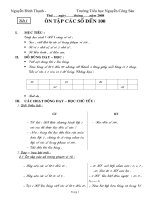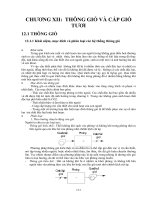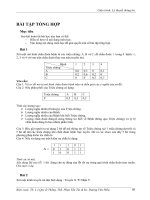- Trang chủ >>
- Mầm non >>
- Mẫu giáo bé
relative 10
Bạn đang xem bản rút gọn của tài liệu. Xem và tải ngay bản đầy đủ của tài liệu tại đây (555.84 KB, 54 trang )
<span class='text_page_counter'>(1)</span><div class='page_container' data-page=1></div>
<span class='text_page_counter'>(2)</span><div class='page_container' data-page=2>
<b>The Period</b>
<b>The Period</b>
<b>and the Comma</b>
<b>and the Comma</b>
Objectives
Use periods correctly at the end of declarative
and imperative sentences, courteous requests,
and indirect questions.
Identify miscellaneous uses of the period.
Use commas correctly between items in a series
and in compound sentences.
</div>
<span class='text_page_counter'>(3)</span><div class='page_container' data-page=3>
<b>The Period</b>
<b>The Period</b>
<b>and the Comma</b>
<b>and the Comma</b>
Objectives
<b>continued</b>
<b>continued</b>
Use commas correctly to set off appositive and
parenthetical expressions.
Use commas correctly with introductory
expressions.
Use commas correctly with nonrestrictive
clauses.
</div>
<span class='text_page_counter'>(4)</span><div class='page_container' data-page=4>
<b>The Period</b>
<b>The Period</b>
<b>and the Comma</b>
<b>and the Comma</b>
<b>Declarative Sentences </b>
Use a period at the end of a declarative
sentence.
<i>Rick finds job openings on the Internet<b>.</b></i>
</div>
<span class='text_page_counter'>(5)</span><div class='page_container' data-page=5>
<b>The Period</b>
<b>The Period</b>
<b>and the Comma</b>
<b>and the Comma</b>
<b>Imperative Sentences </b>
Use a period at the end of a sentence that
indicates a command or a strong suggestion.
<i>Proofread your cover letter carefully<b>.</b></i>
</div>
<span class='text_page_counter'>(6)</span><div class='page_container' data-page=6>
<b>The Period</b>
<b>The Period</b>
<b>and the Comma</b>
<b>and the Comma</b>
<b>Courteous Requests </b>
Use a period at the end of a sentence that
makes a courteous request.
<i>Will you please call the applicants to tell them that </i>
<i>the position is filled<b>.</b></i>
</div>
<span class='text_page_counter'>(7)</span><div class='page_container' data-page=7>
<b>The Period</b>
<b>The Period</b>
<b>and the Comma</b>
<b>and the Comma</b>
<b>Indirect Questions </b>
Use a period after an indirect question.
<i>I wonder whether Bob applied for the accounts </i>
<i>payable position<b>.</b></i>
</div>
<span class='text_page_counter'>(8)</span><div class='page_container' data-page=8>
<b>The Period</b>
<b>The Period</b>
<b>and the Comma</b>
<b>and the Comma</b>
<b>Decimal Points</b>
Use a period to separate dollars and cents.
<i>$5<b>.</b>59</i> <i>$178<b>.</b>25</i> <i> $14,382<b>.</b>38 </i>
Do not place a period after a dollar amount if
there are no cents involved.
<i>$5</i> <i>$802</i> <i> $78,455 </i>
Use a period as a decimal point to express
whole numbers and fractional amounts.
</div>
<span class='text_page_counter'>(9)</span><div class='page_container' data-page=9>
<b>The Period</b>
<b>The Period</b>
<b>and the Comma</b>
<b>and the Comma</b>
<b>Abbreviated Words and </b>
<b>Measurements </b>
Use a period at the end of an abbreviated
word.
<i>assn<b>.</b></i> <i>association</i>
<i>asst<b>.</b></i> <i>assistant</i>
<i>bldg<b>.</b></i> <i>building</i>
<i>intl<b>.</b></i> <i>international</i>
<i>mfg<b>.</b></i> <i>manufacturing</i>
</div>
<span class='text_page_counter'>(10)</span><div class='page_container' data-page=10>
<b>The Period</b>
<b>The Period</b>
<b>and the Comma</b>
<b>and the Comma</b>
<b>Abbreviated Words and </b>
<b>Measurements </b>
Do not use a period after a measurement that
is abbreviated on most business or technical
forms.
<i>Ft</i> <i>foot, feet</i> <i>oz</i> <i>ounce, ounces</i>
<i>gal</i> <i>gallon</i> <i>qt</i> <i>quart, quarts</i>
<i>hr</i> <i>hour, hours</i> <i>yr</i> <i>year, years</i>
<b>continued</b>
<b>continued</b>
</div>
<span class='text_page_counter'>(11)</span><div class='page_container' data-page=11>
<b>The Period</b>
<b>The Period</b>
<b>and the Comma</b>
<b>and the Comma</b>
<b>Small and Capital Letters </b>
Use a period after each letter in abbreviations that
consist of small letters.
<i>a<b>.</b>k<b>.</b>a<b>.</b></i> <i>also known as</i>
<i>c<b>.</b>o<b>.</b>d<b>.</b></i> <i>collect on delivery</i>
<i>f<b>.</b>o<b>.</b>b<b>.</b></i> <i>free on board (within sentences)</i>
Do not use a period after each letter in most
abbreviations that consist of all capital letters.
<i>CEO</i> <i>chief executive officer</i>
</div>
<span class='text_page_counter'>(12)</span><div class='page_container' data-page=12>
<b>The Period</b>
<b>The Period</b>
<b>and the Comma</b>
<b>and the Comma</b>
<b>Small and Capital Letters </b>
Exceptions
<i>P<b>.</b>O<b>.</b></i> <i>post office</i>
<i>U<b>.</b>S<b>.</b></i> <i>United States</i>
<i>M<b>.</b>A<b>.</b></i> <i>Master of Arts</i>
<i>M<b>.</b>D<b>.</b></i> <i>Doctor of Medicine</i>
<i>B<b>.</b>C<b>.</b></i> <i>before Christ</i>
<b>continued</b>
</div>
<span class='text_page_counter'>(13)</span><div class='page_container' data-page=13>
<b>The Period</b>
<b>The Period</b>
<b>and the Comma</b>
<b>and the Comma</b>
<b>Personal Names and </b>
<b>Corporate Names </b>
Use a period after the initials or with abbreviations of
most names.
<i>J<b>.</b> C<b>.</b> Williams</i> <i>Thos<b>.</b> C<b>.</b> McGraw </i>
Do not use a period with a nickname.
<i>Skip Jenner</i> <i>Red Stocker </i>
Use the same format that an individual uses in a
signature or that a company uses on its letterhead as
its official designation
</div>
<span class='text_page_counter'>(14)</span><div class='page_container' data-page=14>
<b>The Period</b>
<b>The Period</b>
<b>and the Comma</b>
<b>and the Comma</b>
<b>Titles, Academic Degrees, </b>
<b>Professional Identification </b>
Use a period after an abbreviation of a
person’s title.
<i>Mrs<b>.</b></i> <i>Ms<b>.</b></i> <i>Mr<b>.</b></i> <i>Dr<b>.</b></i>
Use a period after each element in the
abbreviation of an academic degree or
professional identification.
</div>
<span class='text_page_counter'>(15)</span><div class='page_container' data-page=15>
<b>The Period</b>
<b>The Period</b>
<b>and the Comma</b>
<b>and the Comma</b>
<b>Titles, Academic Degrees, </b>
<b>Professional Identification </b>
Examples
<i>Dr. Carole Bennett accepted a position as a </i>
<i>technical writer.</i>
<i>Sara Wong, M.D., hired Rose to work as a </i>
<i>receptionist.</i>
<i>Gretchen Carpenter, M.B.A., uses the Internet to </i>
<i>post company job openings </i>
<b>continued</b>
</div>
<span class='text_page_counter'>(16)</span><div class='page_container' data-page=16>
<b>The Period</b>
<b>The Period</b>
<b>and the Comma</b>
<b>and the Comma</b>
<b>Seniority Designations </b>
Use a period after an abbreviated seniority
designation.
<i>Jason Harrison Jr<b>.</b> accepted a position in Nevada.</i>
<i>Anthony Biasi III applied for an international </i>
</div>
<span class='text_page_counter'>(17)</span><div class='page_container' data-page=17>
<b>The Period</b>
<b>The Period</b>
<b>and the Comma</b>
<b>and the Comma</b>
<b>The Period and </b>
<b>Geographic Locations </b>
Use a period after an abbreviation of a country,
state, or province unless the abbreviation
appears in ZIP Code format.
NC North Carolina N.C.
AR Arkansas Ark.
ON Ontario Ont.
<b>ZIP Code</b> <b>State or</b> <b>Standard </b>
</div>
<span class='text_page_counter'>(18)</span><div class='page_container' data-page=18>
<b>The Period</b>
<b>The Period</b>
<b>and the Comma</b>
<b>and the Comma</b>
<b>Shortened Forms of Words </b>
Do not use a period after shortened words or
foreign words that are not abbreviations.
<i><b>info</b></i> <i>information</i>
<i><b>rep</b></i> <i>representative</i>
<i><b>specs</b></i> <i>specifications</i>
<i><b>temp</b></i> <i>temporary</i>
<i><b>ad hoc</b></i> <i>for a particular purpose</i>
</div>
<span class='text_page_counter'>(19)</span><div class='page_container' data-page=19>
<b>The Period</b>
<b>The Period</b>
<b>and the Comma</b>
<b>and the Comma</b>
<b>Outlines and Lists </b>
Use a period after the numbers or letters that
identify items in an outline or list unless the
numbers or letters are in parentheses.
<i>I<b>.</b></i> <i>EMPLOYMENT MATERIALS</i>
<i>A<b>.</b></i> <i>Resume</i>
<i>1<b>.</b></i> <i>Chronological</i>
<i>a<b>.</b></i> <i>Advantages</i>
</div>
<span class='text_page_counter'>(20)</span><div class='page_container' data-page=20>
<b>The Period</b>
<b>The Period</b>
<b>and the Comma</b>
<b>and the Comma</b>
<b>Outlines and Lists </b>
Use periods after complete sentences,
dependent clauses, and long phrases in a list
or outline.
<b>continued</b>
<b>continued</b>
<i>The keys to salary negotiation are the following:</i>
<i>1. Discuss salary at the end of the interview<b>.</b></i>
</div>
<span class='text_page_counter'>(21)</span><div class='page_container' data-page=21>
<b>The Period</b>
<b>The Period</b>
<b>and the Comma</b>
<b>and the Comma</b>
<b>Outlines and Lists </b>
Do not use periods after short phrases listed
on separate lines if the lead-in statement is
complete.
<b>continued</b>
<b>continued</b>
<i> Avoid the following job-hunting methods:</i>
<i>1. Unsolicited resumes</i>
<i>2. Employment agencies</i>
</div>
<span class='text_page_counter'>(22)</span><div class='page_container' data-page=22>
<b>The Period</b>
<b>The Period</b>
<b>and the Comma</b>
<b>and the Comma</b>
<b>Compound Sentences </b>
Use a comma to separate two independent
clauses in a compound sentence.
Place the comma before the coordinating
conjunction (<i><b>and, or, nor, but</b></i>) that joins the
two clauses.
<i>Most public libraries have company directories<b>,</b> and most </i>
<i>online services also offer access to these directories.</i>
</div>
<span class='text_page_counter'>(23)</span><div class='page_container' data-page=23>
<b>The Period</b>
<b>The Period</b>
<b>and the Comma</b>
<b>and the Comma</b>
<b>Compound Sentences </b>
Omit the comma before a coordinating
conjunction in a compound sentence if either
or both of the two independent clauses are
very short (four words or less).
<i>Read the job description and fax your résumé. </i>
<b>continued</b>
<b>continued</b>
Do not omit the comma if it is necessary for
clarity.
</div>
<span class='text_page_counter'>(24)</span><div class='page_container' data-page=24>
<b>The Period</b>
<b>The Period</b>
<b>and the Comma</b>
<b>and the Comma</b>
<b>Compound Sentences </b>
Use a comma before the coordinating
conjunction when a subject is not expressed
(but implied) in one or both clauses in an
imperative sentence.
<i>Call companies that interest you<b>,</b> and ask to speak to </i>
<i>people who can give you specific information about </i>
<i>available positions.</i>
<i>Prepare a portfolio of your best work<b>,</b> and bring it with you </i>
<i>to the interview. </i>
<b>continued</b>
</div>
<span class='text_page_counter'>(25)</span><div class='page_container' data-page=25>
<b>The Period</b>
<b>The Period</b>
<b>and the Comma</b>
<b>and the Comma</b>
<b>Compound Sentences </b>
Do not use a comma before a coordinating
conjunction that joins a compound subject,
predicate, object, or subject complement.
<i>Stress educational achievements <b>and</b> extracurricular </i>
<i>activities in your cover letter.</i>
<i>Working in temporary positions will introduce you to </i>
<i>different industries <b>and</b> help you discover the types of </i>
<i>jobs available.</i>
<b>continued</b>
</div>
<span class='text_page_counter'>(26)</span><div class='page_container' data-page=26>
<b>The Period</b>
<b>The Period</b>
<b>and the Comma</b>
<b>and the Comma</b>
<b>Series </b>
Use commas to separate words, phrases, or
clauses in a series.
Include the comma before the coordinating
conjunction.
<i>Be selective when listing job duties<b>,</b> skills<b>,</b> and accomplishments on your </i>
<i>résumé.</i>
<i>Please bring your résumé<b>,</b> a sharpened pencil<b>,</b> and a list of references to </i>
<i>the interview.</i>
</div>
<span class='text_page_counter'>(27)</span><div class='page_container' data-page=27>
<b>The Period</b>
<b>The Period</b>
<b>and the Comma</b>
<b>and the Comma</b>
<b>Series </b>
Do not use commas to separate items when
each item is connected by a conjunction.
<i>Cover letters require the exact last name of the </i>
<i>person <b>and</b> the exact spelling of the name <b>and</b></i>
<i>the title of his or her position.</i>
<b>continued</b>
</div>
<span class='text_page_counter'>(28)</span><div class='page_container' data-page=28>
<b>The Period</b>
<b>The Period</b>
<b>and the Comma</b>
<b>and the Comma</b>
<b>Series </b>
Use commas in a series of names in an organization
exactly the way that the organization uses the commas on
its letterhead or on another verifiable source.
Do not use a comma before the ampersand (&) in the
name of an organization unless the company itself does.
<i>The firm of Farrell<b>,</b> White<b>,</b></i> <i><b>and</b> Jones specializes in </i>
<i>recruiting hospital employees.</i>
<i>Henderson, Hernandez<b>,</b></i> <i><b>&</b> Holmes fills its positions </i>
<i>through networking. </i>
<b>continued</b>
</div>
<span class='text_page_counter'>(29)</span><div class='page_container' data-page=29>
<b>The Period</b>
<b>The Period</b>
<b>and the Comma</b>
<b>and the Comma</b>
<b>The Comma and Etc. </b>
Use a comma before and after the
abbreviation <i><b>etc.</b></i> When <i><b>etc.</b></i> appears at the
end of a sentence, use a comma before the
abbreviation only. The abbreviation <i><b>etc.</b></i>
means <i><b>and so forth</b></i> or <i><b>and others</b>.</i>
Do not use the phrase <i><b>and etc.</b></i>
</div>
<span class='text_page_counter'>(30)</span><div class='page_container' data-page=30>
<b>The Period</b>
<b>The Period</b>
<b>and the Comma</b>
<b>and the Comma</b>
<b>Independent Adjectives </b>
Place a comma between independent adjectives
that precede a noun unless they are already
separated by a coordinating conjunction.
To determine whether adjectives are
</div>
<span class='text_page_counter'>(31)</span><div class='page_container' data-page=31>
<b>The Period</b>
<b>The Period</b>
<b>and the Comma</b>
<b>and the Comma</b>
<b>Independent Adjectives </b>
Examples
<b>continued</b>
<b>continued</b>
<i>James offered <b>vague, disorganized</b> answers </i>
<i>to the interview questions.</i>
<i>Anne conducted a <b>successful, </b></i>
<i><b>well-organized</b> job search.</i>
</div>
<span class='text_page_counter'>(32)</span><div class='page_container' data-page=32>
<b>The Period</b>
<b>The Period</b>
<b>and the Comma</b>
<b>and the Comma</b>
<b>Appositives </b>
Use commas to set off an appositive if it is not
essential to the meaning of a sentence.
<i>Kris Hing<b>, </b>CEO of Hing and Associates<b>,</b> looks </i>
<i>for candidates who speak at least three </i>
<i>languages.</i>
<i>JOBS<b>, </b>an online listing of professional </i>
</div>
<span class='text_page_counter'>(33)</span><div class='page_container' data-page=33>
<b>The Period</b>
<b>The Period</b>
<b>and the Comma</b>
<b>and the Comma</b>
<b>Appositives </b>
Do not use commas to set off an appositive
that explains or clarifies the noun preceding it.
<i>The newspaper National Business </i>
<i>Employment Weekly offers job hunting </i>
<i>strategies.</i>
<i>The year 2001 was the year that I was </i>
<i>promoted to assistant manager. </i>
<b>continued</b>
</div>
<span class='text_page_counter'>(34)</span><div class='page_container' data-page=34>
<b>The Period</b>
<b>The Period</b>
<b>and the Comma</b>
<b>and the Comma</b>
<b>Parenthetical Expressions </b>
Parenthetical expressions interrupt a
sentence. These side remarks do not add to
the clarity of a sentence, and they are set
</div>
<span class='text_page_counter'>(35)</span><div class='page_container' data-page=35>
<b>The Period</b>
<b>The Period</b>
<b>and the Comma</b>
<b>and the Comma</b>
<b>Parenthetical Expressions </b>
Below is a partial list of parenthetical
expressions.
<b>continued</b>
<b>continued</b>
<i>after all</i> <i>as a consequence</i>
<i>as a matter of fact as a result</i>
<i>as a rule</i> <i>as you know</i>
<i>at any rate</i> <i>believe me</i>
<i>by the way</i> <i>for example</i>
<i>however</i> <i>I am sure</i>
</div>
<span class='text_page_counter'>(36)</span><div class='page_container' data-page=36>
<b>The Period</b>
<b>The Period</b>
<b>and the Comma</b>
<b>and the Comma</b>
<b>Parenthetical Expressions </b>
Examples
<b>continued</b>
<b>continued</b>
<i>Being unemployed<b>, as you can see,</b> allowed </i>
<i>me to return to school.</i>
<i><b>Unfortunately,</b> Jack lost his disk that </i>
<i>contained his résumé.</i>
</div>
<span class='text_page_counter'>(37)</span><div class='page_container' data-page=37>
<b>The Period</b>
<b>The Period</b>
<b>and the Comma</b>
<b>and the Comma</b>
<b>Introductory Expressions</b>
<b>Dependent Clauses </b>
Use a comma to separate an introductory
dependent clause from the independent
clause.
<i><b>If I have to move to another state,</b> I will turn </i>
<i>down the job offer.</i>
<i><b>Although the competition was intimidating, </b></i>
</div>
<span class='text_page_counter'>(38)</span><div class='page_container' data-page=38>
<b>The Period</b>
<b>The Period</b>
<b>and the Comma</b>
<b>and the Comma</b>
<b>Introductory Expressions</b>
<b>Dependent Clauses </b>
Generally, do not use a comma when the
dependent clause follows the independent
clause or when the comma is necessary for
the meaning of the sentence.
<i>Do thorough research on a company <b>before any </b></i>
<i><b>job interview.</b></i>
<b>continued</b>
</div>
<span class='text_page_counter'>(39)</span><div class='page_container' data-page=39>
<b>The Period</b>
<b>The Period</b>
<b>and the Comma</b>
<b>and the Comma</b>
<b>Introductory Expressions </b>
<b>Prepositional Phrases</b>
Use a comma to set off an introductory
prepositional phrase from the independent
clause that follows.
<i><b>Within one year,</b> he received a promotion to the </i>
<i>position of accounts payable supervisor.</i>
<i><b>From an employer’s standpoint,</b> a thank-you </i>
</div>
<span class='text_page_counter'>(40)</span><div class='page_container' data-page=40>
<b>The Period</b>
<b>The Period</b>
<b>and the Comma</b>
<b>and the Comma</b>
<b>Introductory Expressions </b>
<b>Infinitive Phrases </b>
Use a comma to set off an introductory infinitive
phrase from the rest of the sentence.
<i><b>To save time,</b> more companies are using résumé </i>
<i>scanning software. </i>
Do not use a comma when an infinitive phrase is the
subject of a sentence.
<i><b>To purposely lie on your employment application</b> may </i>
</div>
<span class='text_page_counter'>(41)</span><div class='page_container' data-page=41>
<b>The Period</b>
<b>The Period</b>
<b>and the Comma</b>
<b>and the Comma</b>
<b>Introductory Expressions </b>
<b>Participial Phrases </b>
Use a comma to set off an introductory
participial phrase from the rest of the
sentence.
<i><b>Surprised by the results of my skill tests,</b> I decided to </i>
<i>set new goals.</i>
<i><b>Reviewing my cover letter,</b> I realized that I had used an </i>
</div>
<span class='text_page_counter'>(42)</span><div class='page_container' data-page=42>
<b>The Period</b>
<b>The Period</b>
<b>and the Comma</b>
<b>and the Comma</b>
<b>Nonrestrictive Adjective Clauses </b>
Use commas to set off a nonrestrictive
adjective clause from the rest of the sentence.
<i>Drug testing<b>, which is becoming more </b></i>
<i><b>prevalent,</b> is a requirement for some occupations.</i>
<i>I carry my resume in a leather portfolio<b>, which </b></i>
</div>
<span class='text_page_counter'>(43)</span><div class='page_container' data-page=43>
<b>The Period</b>
<b>The Period</b>
<b>and the Comma</b>
<b>and the Comma</b>
<b>Restrictive Adjective Clauses </b>
Do not set off a restrictive adjective clause
(necessary for the meaning of the word it
modifies) from the rest of the sentence.
<i>Job applicants <b>who arrive late for their </b></i>
<i><b>interviews </b>are usually not hired at our firm.</i>
<i>A college degree <b>that emphasizes </b></i>
</div>
<span class='text_page_counter'>(44)</span><div class='page_container' data-page=44>
<b>The Period</b>
<b>The Period</b>
<b>and the Comma</b>
<b>and the Comma</b>
<b>Contrasting Expressions </b>
Use commas to set aside a contrasting
expression from the rest of the sentence. A
contrasting expression often begins with the
word not or never. A contrasting expression
contradicts the noun or idea it follows.
</div>
<span class='text_page_counter'>(45)</span><div class='page_container' data-page=45>
<b>The Period</b>
<b>The Period</b>
<b>and the Comma</b>
<b>and the Comma</b>
<b>Direct Address </b>
Use commas to set off the names of
individuals who are being addressed directly.
<i>You will be pleased to know<b>, Larry,</b> that you will </i>
<i>receive a bonus this year.</i>
</div>
<span class='text_page_counter'>(46)</span><div class='page_container' data-page=46>
<b>The Period</b>
<b>The Period</b>
<b>and the Comma</b>
<b>and the Comma</b>
<b>Tag Questions</b>
Use a comma to separate a tag question from
the rest of the sentence.
<i>We have five job candidates to interview </i>
<i>today<b>, don’t we?</b></i>
</div>
<span class='text_page_counter'>(47)</span><div class='page_container' data-page=47>
<b>The Period</b>
<b>The Period</b>
<b>and the Comma</b>
<b>and the Comma</b>
<b>Quotations </b>
Use a comma to introduce a direct quotation
or set it off from other parts of a sentence.
<i>Mr. Bertoli asked me<b>,</b> “How do you define success?”</i>
<i>“Success<b>,</b>” Mr. Bertoli said<b>,</b> “depends upon your own </i>
<i>definition.”</i>
Do not use a comma to set off an indirect
quotation.
</div>
<span class='text_page_counter'>(48)</span><div class='page_container' data-page=48>
<b>The Period</b>
<b>The Period</b>
<b>and the Comma</b>
<b>and the Comma</b>
<b>Dates </b>
Use a comma before and after the year when a
date includes a month, day, and year.
<i>I hope to graduate by June 30<b>,</b> 2005<b>,</b> or at the latest </i>
<i>December 31<b>,</b> 2005. </i>
Do not use a comma if only the month and day or
only the month and year are in a sentence.
<i>Mr. Elias indicated that he would notify me by <b>August 5</b> about </i>
<i>the position.</i>
</div>
<span class='text_page_counter'>(49)</span><div class='page_container' data-page=49>
<b>The Period</b>
<b>The Period</b>
<b>and the Comma</b>
<b>and the Comma</b>
<b>Addresses </b>
Use commas to separate parts of an address
or geographical location.
Do not place a comma between a state name
or a two-letter state abbreviation and the ZIP
Code within a document or on an envelope.
<i>I applied for a position at Sonoma State </i>
</div>
<span class='text_page_counter'>(50)</span><div class='page_container' data-page=50>
<b>The Period</b>
<b>The Period</b>
<b>and the Comma</b>
<b>and the Comma</b>
<b>Occupational Designations, </b>
<b>Academic Degrees </b>
Use commas to set off occupational designations or
academic degrees when they follow a person’s name.
Do not use both a personal or job title before a name
and a job or academic degree designation after the
name.
<i>Pamela Guzman<b>, M.S.,</b> refers her clients for vocational </i>
<i>assessment.</i>
</div>
<span class='text_page_counter'>(51)</span><div class='page_container' data-page=51>
<b>The Period</b>
<b>The Period</b>
<b>and the Comma</b>
<b>and the Comma</b>
<b>Seniority Designations </b>
Do not use commas to separate seniority
designations from the name unless the person
being referenced prefers to use commas.
<i>Lonnie Lamont <b>Jr.</b> works for Diamond Lane </i>
<i>Communications.</i>
<i>Nielson Electronics promoted Richard Whitmore<b> II</b></i>
<i>to the position of comptroller of their Canadian </i>
</div>
<span class='text_page_counter'>(52)</span><div class='page_container' data-page=52>
<b>The Period</b>
<b>The Period</b>
<b>and the Comma</b>
<b>and the Comma</b>
<b>Company Names </b>
Do not use commas to separate <i><b>Inc</b></i>. or <i><b>Ltd</b></i>.
from the rest of the company name unless the
company’s letterhead or other official source
indicates commas are necessary.
</div>
<span class='text_page_counter'>(53)</span><div class='page_container' data-page=53>
<b>The Period</b>
<b>The Period</b>
<b>and the Comma</b>
<b>and the Comma</b>
<b>Numbers</b>
Use a comma in a whole number with more than
four figures. Some prefer to insert a comma in a
number such as 3,482.
<i>Rhonda discovered 12<b>,</b>325 career sites on the Internet. </i>
Do not use a comma in a policy, account, page,
serial, model, or check number or in a house
number in an address.
</div>
<span class='text_page_counter'>(54)</span><div class='page_container' data-page=54></div>
<!--links-->









